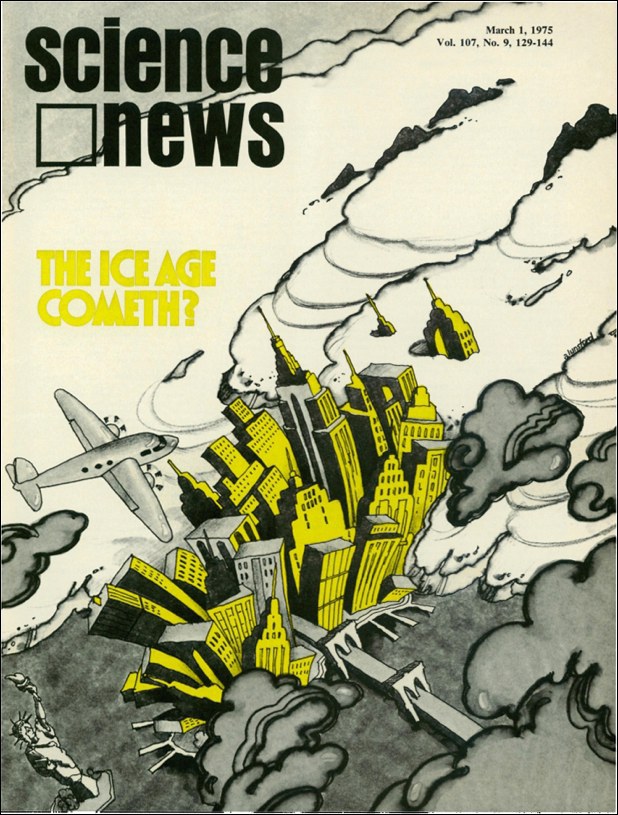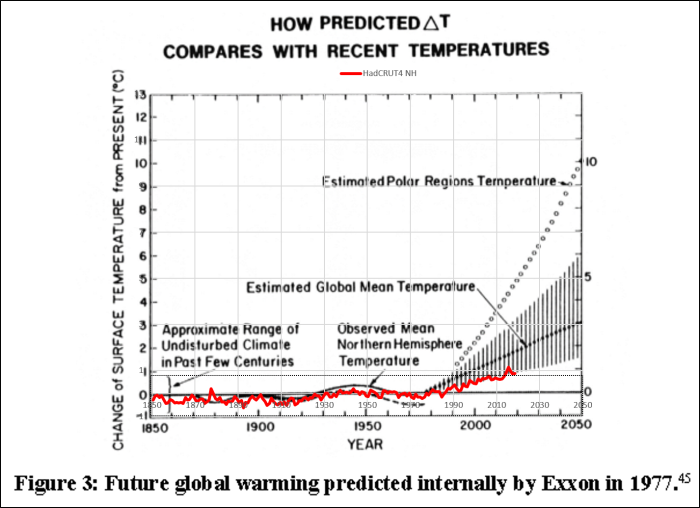https://wattsupwiththat.com/2020/10/28/the-exxonknew-lie-spreads-to-the-automakers/
by David Middleton
INVESTIGATION
Exclusive: GM, Ford knew about climate change 50 years ago
Maxine Joselow, E&E News reporter Published: Monday, October 26, 2020[…]
E&E News obtained hundreds of pages of documents on GM’s corporate history from the General Motors Heritage Center and Wayne State University in Detroit. Documents on Ford’s climate research were unearthed by the Center for International Environmental Law. The Climate Investigations Center provided additional material on both manufacturers.
The investigation reveals striking parallels between two of the country’s biggest automakers and Exxon Mobil Corp., one of the world’s largest publicly traded oil and gas companies. Exxon privately knew about climate change in the late 1970s but publicly denied the scientific consensus for decades, according to 2015 reporting by InsideClimate News and the Los Angeles Times that spawned the hashtag #ExxonKnew and fueled a wave of climate litigation against the oil major.
[…]
The E&E “journalist” has a 2016 BA in English… She probably didn’t take much in the way of science courses, and certainly not in the 1970’s.
Note to Ms. Joselow: Everyone “knew about climate change 50 years ago”…
1963
On the influence of changes in the CO2 concentration in air on the radiation balance of the Earth’s surface and on the climate
F. Möller
AbstractThe numerical value of a temperature change under the influence of a CO2 change as calculated by Plass is valid only for a dry atmosphere. Overlapping of the absorption bands of CO2 and H2O in the range around 15 μ essentially diminishes the temperature changes. New calculations give ΔT = + 1.5° when the CO2 content increases from 300 to 600 ppm. Cloudiness diminishes the radiation effects but not the temperature changes because under cloudy skies larger temperature changes are needed in order to compensate for an equal change in the downward long-wave radiation. The increase in the water vapor content of the atmosphere with rising temperature causes a self-amplification effect which results in almost arbitrary temperature changes, e.g. for constant relative humidity ΔT = +10° in the above mentioned case. It is shown, however, that the changed radiation conditions are not necessarily compensated for by a temperature change. The effect of an increase in CO2 from 300 to 330 ppm can be compensated for completely by a change in the water vapor content of 3 per cent or by a change in the cloudiness of 1 per cent of its value without the occurrence of temperature changes at all. Thus the theory that climatic variations are effected by variations in the CO2 content becomes very questionable.
[…]
In this case, we must distinguish between the assumptions that the water vapor content (in cm l.e.) remains unchanged in spite of heating (cooling) of the atmosphere and that it increases (decreases). Constant absolute humidity means that the relative humidity (f) decreases from 75 to 70.34 per cent with a 1° or lowered by 4.66 per cent per deg. According to the above-mentioned calculations, an increase in CO2 from 300 to 600 ppm gives us a temperature change ΔT = +1.5° for Δf = -4.66 per cent per deg, and a temperature change ΔT = +9.6° for Δf = 0.
[…]
We recognize that for Δf = 0.8 per cent per deg the temperature change becomes infinite. Very small variations effect a reversal of sign or huge amplifications.
It is not too difficult to infer from these numbers that the variation in the radiation budget from a changed CO2 concentration can be compensated for completely without any variation in the surface temperature when the cloudiness is increased by +0.006 or the water vapor content is decreased by -0.07 cm l.e.
[…]
These are variations in the cloudiness by 1 per cent of its value or in the water vapor content by 3 per cent of its value. No meteorologist or climatologist would dare to determine the mean cloudiness or mean water content of the atmosphere with such accuracy; much less can a change of this order of magnitude be proved or its existence denied. Because of these values the entire theory of climatic changes by CO2 variations is becoming questionable.
Möller, F. (1963), On the influence of changes in the CO2 concentration in air on the radiation balance of the Earth’s surface and on the climate. J. Geophys. Res., 68(13), 3877–3886, doi:10.1029/JZ068i013p03877.
1974
The atmosphere’s blanketing effect over the earth’s surface has been compared to the functioning of a greenhouse. Short-wave sunlight passes as easily through the glass of the greenhouse as through the atmosphere. Because glass is opaque to the long-wave radiation from the warm interior of the greenhouse, it hinders the escape of energy.
As a planet, the earth is not warming or cooling appreciably on the average, because it loses as much radiant energy as it gains.
Kolenkow, Robert J., Reid A. Bryson, Douglas B. Carter, R. Keith Julian, Robert A. Muller, Theodore M. Oberlander, Robert P. Sharp & M. Gordon Wolman. Physical geography today : a portrait of a planet. Del Mar, Calif. : CRM Books, [1974]. p. 64.
1975
FORECASTING THE FUTURE. We can now try to decide if we are now in an interglacial stage, with other glacials to follow, or if the world has finally emerged from the Cenozoic Ice Age. According to the Milankovitch theory, fluctuations of radiation of the type shown in Fig. 16-18 must continue and therefore future glacial stages will continue. According to the theory just described, as long as the North and South Poles retain their present thermally isolated locations, the polar latitudes will be frigid; and as the Arctic Ocean keeps oscillating between ice-free and ice-covered states, glacial-interglacial climates will continue.
Finally, regardless of which theory one subscribes to, as long as we see no fundamental change in the late Cenozoic climate trend, and the presence of ice on Greenland and Antarctica indicates that no change has occurred, we can expect that the fluctuations of the past million years will continue.
Donn, William L. Meteorology. 4th Edition. McGraw-Hill 1975. pp 463-464
1975

1976
Suggestion that changing carbon dioxide content of the atmosphere could be a major factor in climate change dates from 1861, when it was proposed by British physicist John Tyndall.
[…]
Unfortunately we cannot estimate accurately changes of past CO2 content of either atmosphere or oceans, nor is there any firm quantitative basis for estimating the the magnitude of drop in carbon dioxide content necessary to trigger glaciation. Moreover the entire concept of an atmospheric greenhouse effect is controversial, for the rate of ocean-atmosphere equalization is uncertain.
Dott, Robert H. & Roger L. Batten. Evolution of the Earth. McGraw-Hill, Inc. Second Edition 1976. p. 441.
Get the picture yet?
Everyone (scientists) knew that CO2 was a “greenhouse gas.” Everyone (scientists) knew that, all other factors held equal, an increase in the concentration of atmospheric CO2 would cause the bulk atmosphere to become somewhat warmer than it otherwise would be. Everyone (scientists) knew that Earth doesn’t allow for all other factors to be held equal. No one knew how sensitive the Earth’s climate was to atmospheric CO2. To this day, no one knows. Every sentient being should know that the benefits of fossil fuels to the well-being of the world have far outweighed any harm that ~1-2 °C of warming may have caused… Particularly since that warming began at the end of the Little Ice Age, the coldest climatic period of the Holocene Epoch. There’s more evidence that the warming and CO2 fertilization have been, on the whole, extremely beneficial than harmful.
Let this sink in
This graph appears as Figure 3 in nearly every bogus climate lawsuit filed against oil companies over the past couple of years:

Here’s the same graph with HadCRUT4 NH overlaid on it:

HadCRUT4 tracks the bottom of the uncertainty range (just like modern climate models) and it is barely exceeding the “approximate range of undisturbed climate in past few centuries.”
Now, process this
According to IPCC AR4, all of the warming since about 1975 can only be explained by anthropogenic forcing. Natural forcing alone (as the IPCC understands it) would have led to the climate being cooler now, than when “the Ice Age Cometh”…




